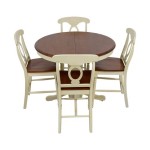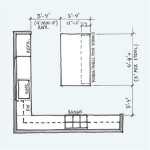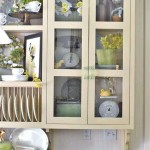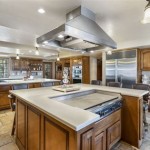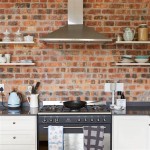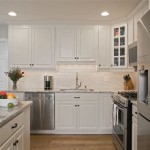Kitchen Islands That Look Like Furniture: Blending Functionality and Style
The kitchen island has evolved significantly from a simple, utilitarian workspace to a central design feature within the modern home. The desire to create kitchens that are both functional and aesthetically pleasing has led to the increasing popularity of kitchen islands that resemble furniture. These islands transcend the standard built-in look, offering a unique opportunity to infuse personality and character into the kitchen space. This article explores the characteristics, benefits, and design considerations associated with kitchen islands that resemble furniture.
A kitchen island designed to resemble furniture typically deviates from the standard, cabinet-based construction often associated with traditional islands. Instead, these islands incorporate design elements reminiscent of freestanding furniture pieces, such as tables, dressers, or even antique consoles. This approach can create a more relaxed and less sterile environment in the kitchen, softening the often-rigid lines of modern cabinetry and appliances.
The aesthetic appeal of these islands lies in their ability to seamlessly blend with the surrounding décor. They can be tailored to complement a variety of interior styles, from rustic farmhouse to sleek contemporary. The key is to select materials, finishes, and details that harmonize with the overall design scheme of the kitchen and the adjacent living spaces. This can include incorporating distressed wood, decorative hardware, or even unique architectural salvage elements.
Key Point 1: Design Elements and Aesthetic Considerations
One of the primary characteristics of a furniture-style kitchen island is its emphasis on visual interest and detail. These islands often feature legs or feet, rather than a solid base, creating a sense of lightness and airiness. The legs can be simple and understated, or they can be ornately carved or turned, depending on the desired aesthetic. The choice of leg style significantly impacts the overall look and feel of the island.
Another element to consider is the countertop material. While granite and quartz are popular choices for traditional islands, furniture-style islands can benefit from more unique and textured materials. Wood countertops, particularly those with a live edge or a reclaimed finish, can add warmth and character. Marble, with its natural veining, can also create a sophisticated and elegant look. The edge profile of the countertop is also important; a beveled or ogee edge can soften the sharp lines and enhance the furniture-like aesthetic.
Hardware plays a crucial role in completing the look. Opting for decorative knobs and pulls, rather than standard cabinet hardware, can further elevate the island's furniture-like qualities. Antique brass, wrought iron, or even glass hardware can add a touch of personality and complement the chosen materials and finishes. The selection of hardware should be consistent with the overall style of the kitchen.
Open shelving is another common feature of furniture-style islands. This allows for the display of decorative items, cookbooks, or even everyday kitchen essentials. Open shelving can also break up the visual mass of the island and create a more inviting and less formal atmosphere. The items displayed on the shelves should be carefully curated to maintain a cohesive and aesthetically pleasing look.
Color is also a vital consideration. While white and gray are popular choices for kitchen cabinets, furniture-style islands often benefit from a pop of color. Painting the island in a contrasting hue can create a focal point and add visual interest to the kitchen. Alternatively, staining the wood in a rich color can enhance its natural beauty and create a warm and inviting atmosphere.
Key Point 2: Functionality and Practical Applications
While aesthetics are important, a kitchen island must also be functional and practical. A furniture-style island should provide ample storage space, a convenient work surface, and potentially a seating area. The design should be carefully considered to meet the specific needs of the homeowner.
Storage can be incorporated in various ways. Drawers are ideal for storing utensils, cookware, and other small items. Cabinets can be used to store larger items, such as pots and pans or even small appliances. Open shelving can be used for displaying decorative items or for storing frequently used items. The storage configuration should be tailored to the homeowner's cooking habits and storage needs.
The work surface should be durable and easy to clean. A countertop made of granite, quartz, or butcher block is a good choice. The height of the countertop should be comfortable for food preparation. A raised countertop can also be incorporated to create a breakfast bar or a casual dining area.
Seating can be added to the island in various ways. Bar stools can be placed along one side of the island to create a casual seating area. Alternatively, a bench can be incorporated into the design to provide more comfortable seating. The seating area should be sized appropriately to accommodate the number of people who will typically be using it.
Consider incorporating features such as a built-in microwave, a wine refrigerator, or even a small sink. These features can add to the convenience and functionality of the island. However, it is important to carefully consider the placement of these features to ensure that they do not detract from the overall aesthetic of the island.
Proper ventilation is crucial, especially if the island includes a cooktop. A downdraft ventilation system can be incorporated into the island to remove smoke and odors. The ventilation system should be powerful enough to effectively remove smoke and odors without being too noisy.
Ensure proper electrical outlets are readily available on the island. This is crucial for powering appliances, charging devices, and providing task lighting. The placement of the outlets should be discreet and aesthetically pleasing.
Key Point 3: Material Selection and Construction Techniques
The choice of materials and construction techniques plays a significant role in the durability and longevity of a furniture-style kitchen island. Selecting high-quality materials and employing proper construction techniques will ensure that the island withstands the wear and tear of daily use.
Solid wood is a popular choice for furniture-style islands. It is durable, aesthetically pleasing, and can be easily repaired if damaged. Hardwoods such as maple, oak, and cherry are good choices. Softwoods such as pine can also be used, but they are more susceptible to scratches and dents.
Plywood and MDF (medium-density fiberboard) are often used for the internal construction of the island. These materials are less expensive than solid wood and are dimensionally stable, meaning they are less likely to warp or crack. However, they are not as durable as solid wood and should be properly sealed to prevent moisture damage.
The construction techniques used to build the island should be strong and durable. Mortise and tenon joints, dovetail joints, and screw-and-glue construction are all good choices. The joints should be carefully fitted and secured to ensure that the island is stable and sturdy.
The finish applied to the island should be durable and water-resistant. A polyurethane finish is a good choice for wood surfaces. This type of finish is resistant to scratches, stains, and water damage. A painted finish should be applied in multiple coats to ensure that it is durable and long-lasting.
Consider using reclaimed materials for the island. Reclaimed wood can add character and history to the kitchen. Reclaimed metal can be used for the legs or other decorative elements. Using reclaimed materials is a sustainable way to create a unique and stylish kitchen island.
When constructing the island, it's imperative to adhere to all local building codes and regulations. This includes ensuring that the island is properly anchored to the floor and that all electrical and plumbing connections are performed by licensed professionals. Failure to comply with building codes can result in costly repairs or even safety hazards. Carefully consider the weight bearing capacity associated with the floor if incorporating materials such as stone, concrete, or steel.
Ultimately, a kitchen island that resembles furniture offers a unique opportunity to personalize the kitchen space and create a focal point that is both functional and aesthetically pleasing. By carefully considering the design elements, functionality, and material selection, homeowners can create an island that seamlessly blends with their existing décor and enhances the overall appeal of their kitchen.

90 Modern Kitchen Island Ideas To Transform Your Home In 2025

Kitchen Confidential 11 Islands With Furniture Style

Kitchen Island Design Finding Lovely

Repurposed Kitchen Island Ideas Inspiration Kara Layne

Your Guide To 6 Kitchen Island Styles

Custom Kitchen Islands Crafted From Reclaimed Wood Offer Nostalgia And Functionality Shenandoah Home

Custom Kitchen Island With Large Furniture Legs Etsy

5 Kitchen Island Features Worth Considering Youtube

Get Their Look Bespoke Kitchen Island H Is For Home Harbinger

Popular Kitchen Island Features


